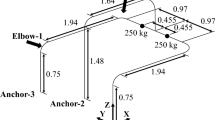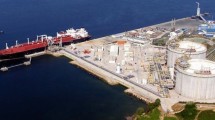Abstract
This paper proposes an elastic-plastic-based decoupling criterion that can be applied to the seismic analysis of large-scale complex piping systems in nuclear power plants under beyond design basis earthquakes. First, the existing elastic-based decoupling criteria for seismic analyses were critically reviewed. Next, the effect of plasticity on the decoupling criteria was investigated by considering the equivalent damping and stiffness reduction. Finally, the decoupling criterion considering plasticity was developed based on the changes resulting from existing decoupling criteria. The validity of the proposed decoupling criterion was confirmed through its application to an analysis of a real piping system.
Similar content being viewed by others
Abbreviations
- m :
-
Mass
- c :
-
Damping coefficient
- k :
-
Stiffness
- ω :
-
Natural frequency
- x :
-
Displacement
- ζ :
-
Damping ratio
- e :
-
Frequency error rate in undamped system
- e d :
-
Frequency error rate in damped system
- r f :
-
Frequency ratio
- r m :
-
Mass ratio
- p:
-
Primary system
- s:
-
Secondary system
- c:
-
Combined system
References
ASME B&PV Code Committee, Section III, The American Society of Mechanical Engineers (2015).
IAEA, Safety of Nuclear Power Plants: Design, Specific Safety Requirements No. SSR-2/1 (Rev. 1), International Atomic Energy Agency (2016).
U. S. Nuclear Regulatory Commission, Near-Term Report and Recommendations for Agency Actions Following the Events in Japan, SECY-11-0093, United States Nuclear Regulatory Commission (2011).
M. Morishita, A. Otani, T. Watakabe, I. Nakamura, T. Shibutani and M. Shiratori, Seismic qualification of piping systems by detailed inelastic response analysis: Part 1—A code case for piping seismic evaluation based on detailed inelastic response analysis, ASME 2017 Pressure Vessels and Piping Conference, American Society of Mechanical Engineers Digital Collection (2017).
A. Otani, T. Shibutani, M. Morishita, I. Nakamura, T. Watakabe and M. Shiratori, Seismic qualification of piping system by detailed inelastic response analysis: Part 2—A guideline for piping seismic inelastic response analysis, ASME 2017 Pressure Vessels and Piping Conference, American Society of Mechanical Engineers Digital Collection (2017).
I. Nakamura, A. Otani, M. Morishita, M. Shiratori, T. Watakabe and T. Shibutani, Seismic qualification of piping systems by detailed inelastic response analysis: Part 3—Variation in elastic-plastic analysis results on carbon steel pipes from the benchmark analyses and the parametric analysis, ASME 2017 Pressure Vessels and Piping Conference, American Society of Mechanical Engineers Digital Collection (2017).
T. Watakabe, I. Nakamura, A. Otani, M. Morishita, T. Shibutani and M. Shiratori, Seismic qualification of piping systems by detailed inelastic response analysis: Part 4—Second round benchmark analyses with stainless steel piping component test, ASME 2017 Pressure Vessels and Piping Conference, American Society of Mechanical Engineers Digital Collection (2017).
U. S. Nuclear Regulatory Commission, Standard Review Plan, Section 3.7.2, United States Nuclear Regulatory Commission (1975).
R. D. T. Standard F9-2T, Seismic Requirements for Design of Nuclear Power Plants and Test Facilities (1974).
C. W. Lin and T. H. Liu, A Discussion of Coupling and Resonance Effects for Integrated Systems Consisting of Subsystems (No. AED-CONF-75-365-000) (1975).
G. Chen and J. Wu, Transfer-function-based criteria for decoupling of secondary systems, Journal of Engineering Mechanics, 125(3) (1999) 340–346.
A. H. Hadjian, On the decoupling of secondary systems for seismic analysis, Proc. of Sixth World Conference on Earthquake Engineering, New Delhi, India (1977).
A. K. Gupta and J. M. Tembulkar, Dynamic decoupling of multiply connected MDOF secondary systems, Nuclear Engineering and Design, 81(3) (1984) 375–383.
T. Igusa and A. Der Kiureghian, Dynamic characterization of two-degree-of-freedom equipment-structure systems, Journal of Engineering Mechanics, 111(1) (1985) 1–19.
L. Lazzeri, Effects of plasticity on dynamic response of piping structures, Journal of Pressure Vessel Technology, 110 (1988) 263.
A. V. Papageorgiou and C. J. Gantes, Decoupling criteria for inelastic irregular primary/secondary structural systems subject to seismic excitation, Journal of Engineering Mechanics, 136(10) (2010) 1234–1247.
S. M. Toolbox, Matlab. Mathworks Inc. (1993).
JSME, An Alternative Rules on Seismic Design of Seismic S Class Piping by Elastic-plastic Response Analysis, Japan Society of Mechanical Engineers, Tokyo, Japan, Standard No. JSME NC-CC-008 (2019) (in Japanese).
D. S. Simulia, A. Fallis and D. Techniques, Abaqus 6.14 Online Documentation, Abaqus Web (2018).
K. E. P. Corporation & K. H. N. Power, APR1400 Design Control Document Tier 2, APR1400-K-X-FS-14002-NP, Korea Electric Power Corporation & Korea Hydro and Nuclear Power Co., Ltd. (2014).
J. W. Kim, M. R. Choi and Y. J. Kim, Effect of loading rate on the fracture behavior of nuclear piping materials under cyclic loading conditions, Nuclear Engineering and Technology, 48(6) (2016) 1376–1386.
Y. J. Kim, J. W. Kim, J. S. Kim, Y. W. Kim, H. S. Nam and M. L. Choi, A method to predict accumulated damage and failure of cracked nuclear piping under seismic loading conditions, Final Report (2016).
Acknowledgments
This work was supported by the Korea Institute of Energy Technology Evaluation and Planning (KETEP) (No. 20171520 101650 and No. 20181510102380).
Author information
Authors and Affiliations
Corresponding author
Additional information
Jong-Sung Kim is an Associate Professor at the Department of Nuclear Engineering, Sejong University, Seoul, Korea. He received his Ph.D. in Mechanical Engineering from Yonsei University. His research interests include residual stresses, fatigue, fracture, and damage mechanics.
Soo-Bin Kim is a candidate for the Master degree of Engineering in Mechanical Engineering, Korea University, Seoul, Korea. He received his B.S. degree in 2018 from Korea University. His research interests include structural integrity assessments based on fracture mechanics using computational analysis.
Rights and permissions
About this article
Cite this article
Kim, SB., Kim, YJ. & Kim, JS. Decoupling criterion for elastic-plastic seismic analysis of large-scale complex piping systems in nuclear power plants. J Mech Sci Technol 34, 4563–4573 (2020). https://doi.org/10.1007/s12206-020-1015-5
Received:
Revised:
Accepted:
Published:
Issue Date:
DOI: https://doi.org/10.1007/s12206-020-1015-5




